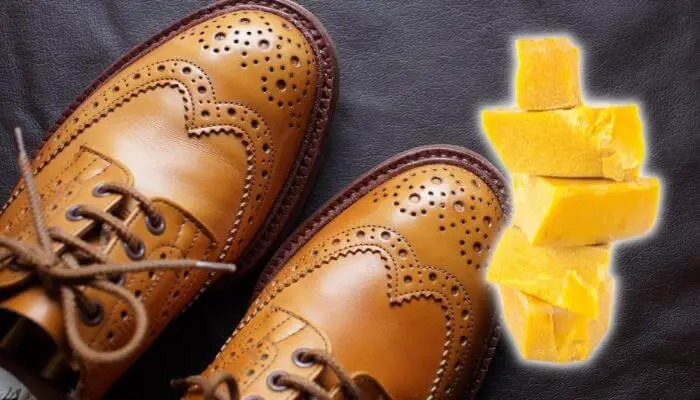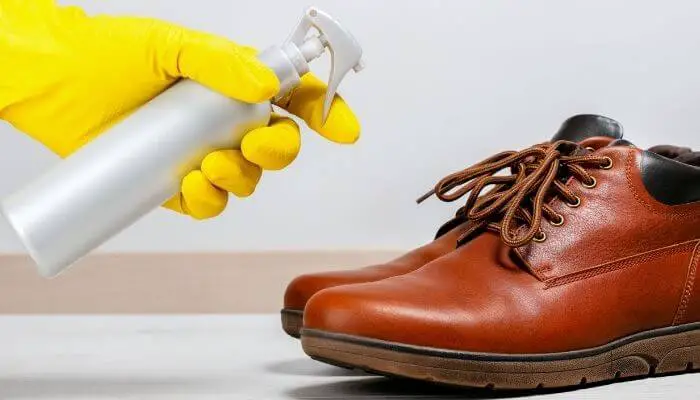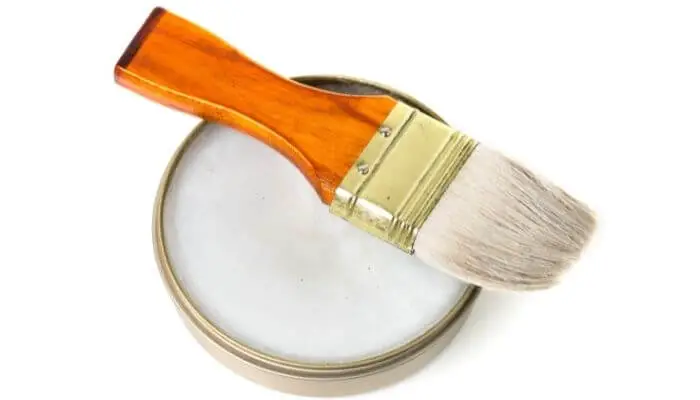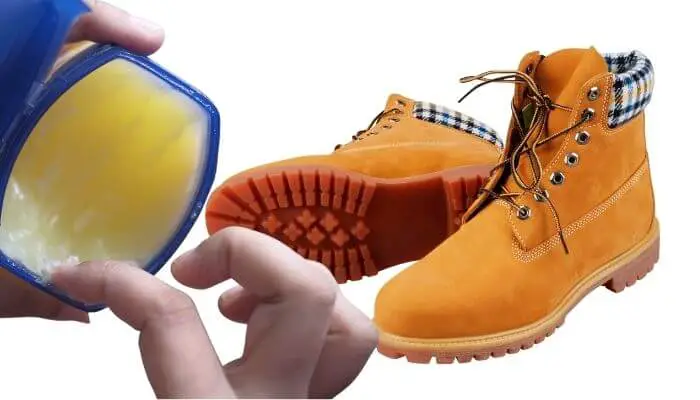You can easily waterproof your shoes in a number of different ways including applying wax, waterproof spray, or even by using mink oil.
Keep reading for a breakdown of each method:
1. Use Beeswax
Wax is the OG when it comes to waterproofing shoes.
It lasts for months and works on leather, canvas, suede and other fabric shoes.

You can use commercial waxes made for waterproofing shoes or beeswax or candle wax.
Follow these steps to successfully waterproof your shoes with beeswax:
- Make sure that your shoes are clean and dry. This is crucial because once you’ve put the wax on them, you won’t be able to clean any stain underneath. Also, wax needs a clean and dry surface to successfully adhere to it.
- Test the wax first on a small spot to ensure that the wax you’re using won’t stain or discolor your shoes.
- If everything is okay after the testing step, grab your beeswax, candle, or whatever type of wax you’re using and rub it well on the whole upper part of your shoes.
- Don’t forget to rub the seams as well, as these are the first parts to let water through.
- Bring your hairdryer and set it on high to melt the wax. Don’t skip this part, as the heat is what melts the wax and works it into the fabric.
- It’s time to let your shoes cool down.
- Pour some water on it to see if it really works.
- If not, you might need to add another layer of wax.
You need to make sure that you’re using colorless beeswax. If it’s colored, it’ll most likely cause discoloration.
Also, don’t freak out if your shoes get a bit darker when melting the wax. This is normal. They turn back to their original color after cooling.
If you expect to expose your shoes to water more frequently, then it’s best to add a second layer of wax. You also might need to reapply more regularly. But don’t worry; wax stays for an extended period anyway.
2. Use Waterproof Spray
This method is the second best to waterproof your shoes.
It’s not the top choice because waterproof sprays don’t last as long as wax.

Plus, its usually more expensive.
However, it’s easy to use and you can find a wide range of waterproof sprays that work for each and every material, including suede or sneakers.
We recommend silicone waterproof sprays over acrylic ones as they’re generally better and last longer. Though keep in mind that silicone sprays are more expensive.
To waterproof your shoes using waterproof spray:
- First, clean your shoes from any stains and let them dry.
- If it’s possible, hang the shoes by the laces to get complete and easy access to every part of the shoe.
- While holding the spray can at least 6 inches away from the shoes, spray the whole upper part. Don’t forget to spray the seams.
- Apply at least two coats of spray to ensure you didn’t miss a part.
- It’s recommended to use a dry, clean cloth or a microfiber towel to blot the excess solution off the shoes.
- Let your shoes dry for at least 24 hours away from sunlight to give the spray enough time to do its job.
Always remember to read and follow the instructions on the spray can to avoid oversaturating your shoes.
Another thing to remember is to spray your shoes outside the house, maybe in the garage.
This is because sprays can create a mess.
If it’s not possible to do it outside the house, then lay down newspaper to catch any spills and open your windows.
Waterproof sprays usually last for a few months, depending on the product you’re using.
If your shoes are exposed to water frequently, you will need to reapply it more frequently.
3. Use Mink Oil
This is another OG product to waterproof your shoes, but be aware, that mink oil only works on leather shoes.
As well as waterproofing your leather shoes, mink oil will also leave them soft and supple.

It’s easy to waterproof shoes with mink oil. Just follow these steps:
- Make sure your leather shoes are clean and completely dry.
- With a dry, clean cloth, rub the oil into the entire upper surface of your leather shoes.
- Leave the oil to soak in for a couple of minutes, then wipe away the extra.
Be careful not to use mink or neatsfoot oil on expensive dress shoes or shiny leather.
These types of oil can discolor your leather shoes.
Also, you won’t be able to get that high shine with polishing when using mink or neatsfoot oil.
We recommend only using oil to waterproof leather hiking boots or shoes that you aren’t tp precious about preserving the appearance of.
This method will last for months without having to reapply.
4. Use Petroleum Jelly
I’d only use petroleum jelly if you need a quick, temporary way to waterproof your shoes.
Petroleum jelly doesn’t last as long as the previous methods.

Also, it can be a bit messy to apply and set it on shoes.
To waterproof your shoes using petroleum jelly, just follow the same steps of applying mink oil.
In this case, you can set the petroleum jelly with heat for extra penetration, just like we did with wax.
I recommend using no other petroleum jelly than Vaseline because it’s simply the best, and it’s colorless.
However, it can still cause some discoloration. So only use it if there’s no other choice.
5. Use WD-40
WD-40 is a spray that is used on machine parts to prevent water from penetrating through.
It’s not the best to use on shoes or boots as it can cause discoloration, however it can be an effective option if you can’t go for the other methods.
You just spray it on as if you’re spraying a commercial waterproof spray.
It doesn’t last long and isn’t the best waterproofer, but it’s usable if you need a quick solution.
Conclusion
These are several ways to waterproof your shoes.
So choose the method that best suits your needs and, of course, your shoe material.
I recommend removing the laces to get full access to your upper shoe surface and waterproof the laces separately.
Also, don’t forget to apply your waterproofer on the tongue, sidewalls, heel, and the toe part as well.
